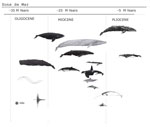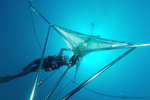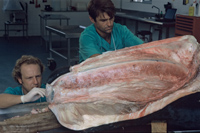The LAB is involved in the organisation and teaching of different courses.
Information about them can be found below
Sons de Mar
 The sea has always been a meeting area for natural and biological noise. During their
evolution, beginning 30 millions of years ago, cetaceans have adapted their acoustic signals
depending on this natural environment. However, in the last 100 years, human activities
have introduced artificial sound sources that directly compete with the sea's natural
acoustic space. An experience hardly compatible with the conservation of the marine
environment. At Sons de Mar, visitors can listen to both the natural and
unnatural sounds in the oceans and they can learn about the fundamental
role of acoustics in cetaceans' lives.
The sea has always been a meeting area for natural and biological noise. During their
evolution, beginning 30 millions of years ago, cetaceans have adapted their acoustic signals
depending on this natural environment. However, in the last 100 years, human activities
have introduced artificial sound sources that directly compete with the sea's natural
acoustic space. An experience hardly compatible with the conservation of the marine
environment. At Sons de Mar, visitors can listen to both the natural and
unnatural sounds in the oceans and they can learn about the fundamental
role of acoustics in cetaceans' lives.
MAS, Master on Marine Technologies and Acoustic Sensing.
 This course is a taught Master of Science providing advanced training in
applied aspects of marine underwater acoustic technology and remote sensing
through lectures, seminars, practical courses, desk studies and research
projects. The MAS is of interest to students willing to be involved in
engineering development and application of underwater acoustics research,
including sonar equipment, oceanography technologies, bioacoustics and
underwater communication for scientific, industrial and environmental
purposes. It is also extremely relevant to students with backgrounds in
Fisheries, Environmental Sciences and Marine Biology involved in the field
use of advanced acoustics underwater technologies. It is specially designed
to lead to Doctoral Dissertations on Underwater Acoustic Technologies.
This course is a taught Master of Science providing advanced training in
applied aspects of marine underwater acoustic technology and remote sensing
through lectures, seminars, practical courses, desk studies and research
projects. The MAS is of interest to students willing to be involved in
engineering development and application of underwater acoustics research,
including sonar equipment, oceanography technologies, bioacoustics and
underwater communication for scientific, industrial and environmental
purposes. It is also extremely relevant to students with backgrounds in
Fisheries, Environmental Sciences and Marine Biology involved in the field
use of advanced acoustics underwater technologies. It is specially designed
to lead to Doctoral Dissertations on Underwater Acoustic Technologies.
Cetacean Bio-sonar and Communication : Mechanism and Social Behaviour
 The scientific interest that lies behind the study of whales and dolphins
has recently become a conservation issue. The knowledge of the cetacean
biology, in terms of fundamental aspects of health and correct functionality
of these marine mammal species vital systems, cannot anymore be dissociated
from natural or anthropogenic factors that may induce negative effects on
the organism or the population and be interpreted like an unequivocal signal
of the ecosystem imbalance. Against this background, it appears fundamental
to better comprehend the cetacean perception of the habitat where these
species develop their daily activities, not from our perspective like
terrestrial mammals that live in an aerial environment, but through the
sensorial systems that cetaceans have developed along the several millions
of years of evolution in a marine context. Without discarding the
importance of other senses, the use of the acoustic signals, in terms of
production, reception and process, allows to approach great part of the
vital information that, among other functions, guarantees the social
coherence, the search of food and a correct reproduction rate of an
individual or a population.
The scientific interest that lies behind the study of whales and dolphins
has recently become a conservation issue. The knowledge of the cetacean
biology, in terms of fundamental aspects of health and correct functionality
of these marine mammal species vital systems, cannot anymore be dissociated
from natural or anthropogenic factors that may induce negative effects on
the organism or the population and be interpreted like an unequivocal signal
of the ecosystem imbalance. Against this background, it appears fundamental
to better comprehend the cetacean perception of the habitat where these
species develop their daily activities, not from our perspective like
terrestrial mammals that live in an aerial environment, but through the
sensorial systems that cetaceans have developed along the several millions
of years of evolution in a marine context. Without discarding the
importance of other senses, the use of the acoustic signals, in terms of
production, reception and process, allows to approach great part of the
vital information that, among other functions, guarantees the social
coherence, the search of food and a correct reproduction rate of an
individual or a population.
|

